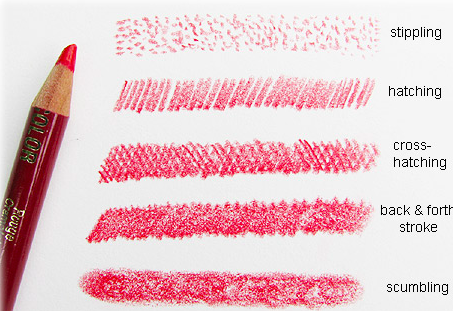Colored Pencils Techniques1. Pressure Shading- apple pressure to create different values and tones 2. Strokes- apply shading, stippling, cross-hatching, and hatching to create textures 3. Layering- apply similar or opposite colors to layer on top of each other to create depth 4. Blending- creating an area between two colors where they gradually mix, so you get a gentle transition from one color to the other. 5. Burnishing- push the color pencils on paper to produce solid color painting quality effects.6. Highlights and shadows- enhance 3D effects
1. Pressure shading-create values

Shading With Different Values to improve your drawing.
2. Strokes- create textures

Shading: produced with an even, side-to-side stroke that creates a smooth even layer of color; a light touch will deposit a faint amount of color for graduated colored pencil shading.

Hatching: a series of evenly spaced, parallel lines that leave a little white or color of the underlying surface visible; hatching in colored pencil adds texture to your compositions.

Cross-hatching: hatching overlaid at an angle to build up layers of color or value; keep the pencil tips sharp to create fine, even lines.
Consider the Direction of the Strokes
3. Layering- create depth
Layering colors produce more depth in the color and lead to a more realistic depiction of the scene. Layered colors may be related or similar colors, or they may be complete opposites.
Layering colors of a different value or hue naturally mix on the surface and mixed colors are always more natural in their appearance.
4. Blending- create color gradians
 Produced by applying heavy, even pressure with a pigment less blending pencil or a white or light-colored pencil (such as cream or light gray), creating slick, evenly blended color; a stiff bristle brush can be used to blend colors as well. Colored pencil blending techniques can help add depth to your colored pencil drawings. A colorless marker can also be used to blend layers of color together.
Produced by applying heavy, even pressure with a pigment less blending pencil or a white or light-colored pencil (such as cream or light gray), creating slick, evenly blended color; a stiff bristle brush can be used to blend colors as well. Colored pencil blending techniques can help add depth to your colored pencil drawings. A colorless marker can also be used to blend layers of color together.
 Produced by applying heavy, even pressure with a pigment less blending pencil or a white or light-colored pencil (such as cream or light gray), creating slick, evenly blended color; a stiff bristle brush can be used to blend colors as well. Colored pencil blending techniques can help add depth to your colored pencil drawings. A colorless marker can also be used to blend layers of color together.
Produced by applying heavy, even pressure with a pigment less blending pencil or a white or light-colored pencil (such as cream or light gray), creating slick, evenly blended color; a stiff bristle brush can be used to blend colors as well. Colored pencil blending techniques can help add depth to your colored pencil drawings. A colorless marker can also be used to blend layers of color together.
5. Burnishing- create painting quality
Burnishing is the process of working the material into the tooth of the paper to produce smooth and solid applications of color. This is what transforms a colored pencil drawing into a colored pencil painting.
6. Highlight and Shadow- create 3D effects
Adding highlights and shadows to create 3D effects on the 2D surface















